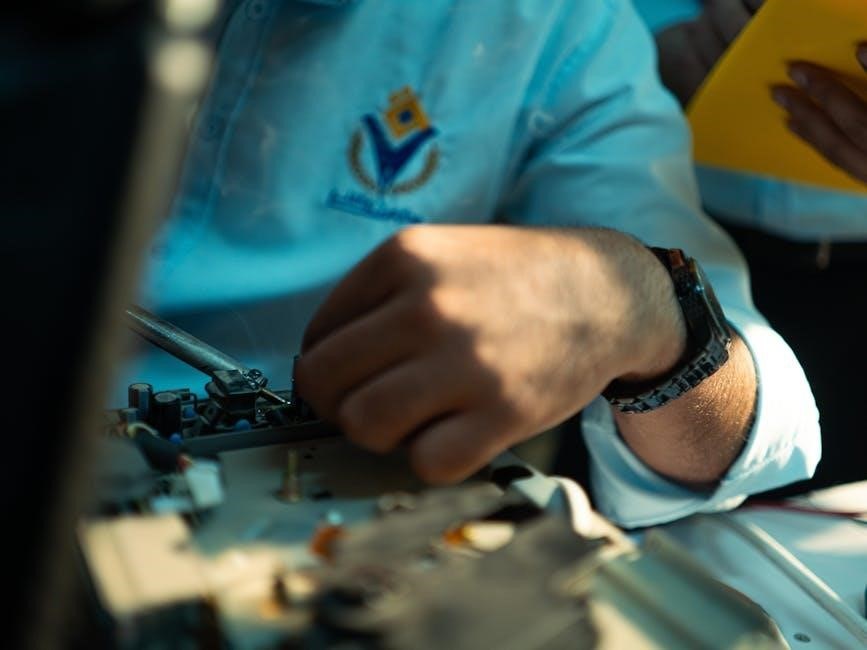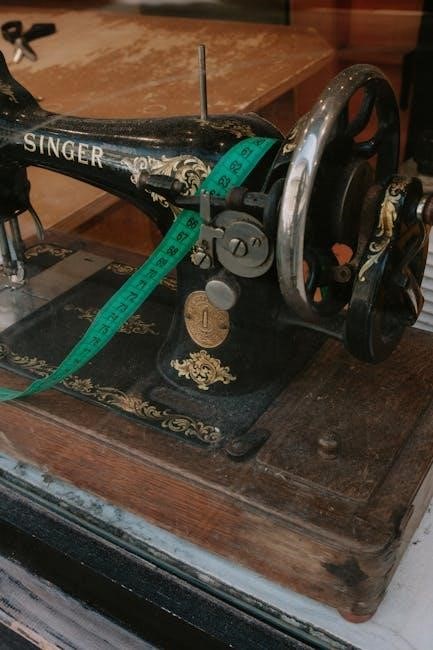The Singer 401A manual provides essential guidance for operating and maintaining this durable, all-metal sewing machine. It covers threading, maintenance, and troubleshooting, ensuring optimal performance and longevity.
1.1 Overview of the Singer 401A Sewing Machine
The Singer 401A is a robust, all-metal sewing machine known for its durability and versatility. Manufactured in Anderson, SC, with cabinets made in Pickens, SC, it features a slant needle mechanism for improved stitch visibility. This heavy-duty machine is ideal for various sewing tasks, including piecing, appliqué, and quilting. Its construction ensures long-lasting performance, making it a favorite among sewists. The 401A is often praised for its reliability and ease of use, making it a valuable addition to any sewing room. Its metal build and powerful motor allow it to handle heavy fabrics with ease.
1.2 Importance of the Manual for Operation and Maintenance
The Singer 401A manual is crucial for understanding the machine’s operation and maintenance. Available for free download from Singer’s website, it provides detailed instructions for threading, oiling, and troubleshooting. The manual ensures proper setup and maintenance, extending the machine’s lifespan. It guides users through essential tasks, helping both beginners and experienced sewists. Regular maintenance, as outlined, prevents issues like motor slowdowns. The manual is indispensable for optimizing performance and addressing common problems, making it a vital resource for anyone owning a Singer 401A.

History and Background of the Singer 401A
The Singer 401A was produced from 1957 to 1961 in Anderson, SC, with cabinets made in Pickens, SC. It’s a durable all-metal machine, highly regarded for its reliability and versatility in sewing.
2.1 Production Years and Manufacturing Locations
The Singer 401A was produced from 1957 to 1961, primarily in Anderson, South Carolina. The machine’s cabinet was manufactured in Pickens, SC. Known for its all-metal construction, it became a durable and reliable choice for sewists. The Singer 401A manual, available for download from Singer’s official website, provides detailed guidance on operation and maintenance. This model is celebrated for its slant needle mechanism, making it ideal for various sewing tasks, including heavy fabrics and quilting. Its robust design and versatility have made it a favorite among sewing enthusiasts for decades.
2.2 Evolution of the Singer 401A Model
The Singer 401A evolved from earlier Singer models, notably the Singer 301, with enhancements in design and functionality. It introduced a slant needle mechanism, improving stitch quality and fabric handling. The machine’s construction emphasized durability, with an all-metal frame and high-quality components. Over time, Singer refined the 401A, adding features like automatic stitch length control and a wider range of stitch options. These advancements made it versatile for both home and light industrial use, solidifying its reputation as a reliable sewing machine. Its evolution reflects Singer’s commitment to innovation and user satisfaction.

Key Features of the Singer 401A
The Singer 401A boasts an all-metal construction for durability, a slant needle mechanism for superior stitching, and versatility with various stitch options, making it ideal for diverse fabrics and sewing needs while maintaining portability and ease of use.
3.1 All-Metal Construction and Durability
The Singer 401A is renowned for its robust all-metal construction, ensuring exceptional durability and longevity. Unlike machines with plastic components, its metal parts withstand heavy use and resist wear. This sturdy build allows for consistent stitching performance and minimal mechanical issues over time. The absence of plastic ensures reliability, making it a trusted choice for sewists who prioritize quality and longevity. Its metal frame also contributes to better stability during operation, reducing vibrations and ensuring smooth sewing experiences. This durable design makes the Singer 401A a worthwhile investment for both casual and dedicated sewers.
3.2 Slant Needle Mechanism and Its Benefits
The Singer 401A features a slant needle mechanism, designed to enhance sewing efficiency and versatility. This mechanism allows for superior visibility, making it easier to align fabrics and monitor stitching. It also enables smoother operation when sewing thick or layered materials, reducing fabric drag and bunching. The slant needle promotes even stitching and minimizes skipped stitches, especially on heavy-duty projects. This innovative design contributes to the machine’s overall performance, ensuring precise and professional-looking results for both home and industrial sewing tasks. Its benefits make the Singer 401A a favorite among sewists seeking reliability and adaptability.

Maintenance and Care
Regular maintenance ensures the Singer 401A’s longevity and performance. Proper cleaning, oiling, and lubrication prevent mechanical issues, while timely care extends the machine’s reliability and service life.
4.1 Oil Requirements and Application
Proper oiling is essential for the Singer 401A’s smooth operation. Use high-quality sewing machine oil to lubricate moving parts, such as the bobbin hook and needle bar. Apply a few drops to the specified points, as indicated in the manual, after cleaning. Regular oiling prevents friction and ensures longevity. Avoid over-oiling to keep the machine free from residue buildup. Oil should be applied after every use or at least once a week with frequent use. Neglecting oiling can lead to mechanical wear and potential damage to internal components over time.
4.2 Cleaning the Machine and Removing Old Grease
Regular cleaning is crucial for maintaining the Singer 401A’s performance. Use a soft, dry cloth to wipe down the machine’s exterior, removing dust and debris. For internal areas, gently brush away lint and threads. Old grease can harden over time, affecting functionality. Apply a small amount of sewing machine degreaser or kerosene to a cloth, then carefully wipe away greasy buildup. Avoid soaking or using harsh chemicals, as they may damage the finish or harm internal components. Regular cleaning ensures smooth operation and prevents damage from accumulated grime and residue.
Accessories and Attachments
The Singer 401A offers a variety of accessories, including specialized presser feet, needles, and custom cams, enhancing functionality and customization for diverse sewing projects.
5.1 Cams and Their Functions
Cams are essential components of the Singer 401A, enabling various stitch patterns. These interchangeable disks control the needle’s movement, creating straight, zigzag, or decorative stitches. Each cam corresponds to specific stitch types, allowing users to customize projects. To use a cam, it must be correctly aligned and secured in the machine. The manual provides detailed instructions for installation and compatibility, ensuring optimal performance. Cams expand the machine’s versatility, making it suitable for embroidery, quilting, and heavy-duty sewing. Proper cam selection enhances stitching accuracy and creativity, making it a vital accessory for diverse sewing needs.
5.2 Presser Feet and Their Uses
Presser feet are crucial accessories for the Singer 401A, designed to handle various sewing tasks with precision. The general-purpose foot is ideal for straight stitching, while the zigzag foot works seamlessly with the machine’s slant needle mechanism. Specialized feet, like the zipper foot, are perfect for sewing zippers or thick fabrics. The blind hem foot is great for invisible hems, and the buttonhole foot simplifies creating custom buttonholes. Each foot attaches easily, enhancing control and accuracy. Using the right presser foot ensures professional results, making it essential for diverse sewing projects.

The Singer 401A Manual
The Singer 401A manual is a comprehensive guide essential for understanding and optimizing the machine’s operation, maintenance, and troubleshooting, ensuring users maximize its potential effectively.
6.1 Availability and Download Options
The Singer 401A manual is readily available online, with digital versions accessible through Singer’s official website and various sewing enthusiast forums. Users can download it as a PDF, ensuring compatibility with most devices. Additionally, third-party websites specializing in vintage sewing machine manuals often host copies. For those preferring physical versions, printed manuals can be purchased from select retailers or eBay. Availability varies by region, but digital access remains the most convenient option for global users seeking immediate access to operation and maintenance guidance.
6.2 Key Sections of the Manual
The Singer 401A manual is divided into essential sections designed to guide users through operation, maintenance, and troubleshooting. Key sections include a detailed parts diagram, threading and bobbin instructions, and stitch selection charts. The manual also covers oiling points, tension adjustment, and common repair procedures. Additional sections focus on accessory usage, such as cams and presser feet, while troubleshooting guides help diagnose and resolve mechanical issues. These sections ensure comprehensive understanding and optimal use of the Singer 401A sewing machine, catering to both beginners and experienced sewists.

Setup and Initial Use
Unpack the Singer 401A, place it on a sturdy table, and ensure proper electrical connection. Apply oil as instructed, prepare the bobbin, and thread the machine carefully. Test stitches on scrap fabric to ensure smooth operation before starting projects.
7.1 Threading the Machine
Threading the Singer 401A requires attention to detail to ensure proper stitch formation. Begin by placing the spool on the spool pin and guide the thread through the tension discs.
Next, pass the thread through the take-up lever and the needle bar. Finally, insert the thread into the needle’s eye. Always refer to the manual’s diagram for correct threading paths. Proper tension is crucial to prevent tangles or uneven stitches. Regularly check and adjust the thread flow to maintain smooth operation. This step is foundational for consistent sewing performance.
7.2 Understanding Basic Stitching Techniques
Mastering basic stitching techniques on the Singer 401A is essential for achieving professional results. Start with the straight stitch, ideal for general sewing and suitable for most fabrics. Backstitching at the beginning and end of seams ensures durability. For heavier fabrics, use the reverse lever to reinforce stitches. The Singer 401A also supports basic zigzag stitching for stretchy materials or decorative edges. Always test stitches on scrap fabric to adjust length and width settings. Proper technique ensures even, consistent stitching, enhancing the quality of your projects.

Troubleshooting Common Issues
The Singer 401A may face issues like uneven stitching or jamming. Check thread tension, ensure proper needle alignment, and clean debris regularly to resolve problems effectively.
8.1 Diagnosing Motor and Belt Problems
Motor issues in the Singer 401A often stem from worn belts or misalignment. Start by checking the power supply and ensuring all electrical connections are secure. If the motor hums but doesn’t run, inspect for belt slippage or cracks. Replace the belt if damaged, as it can cause uneven operation. Proper alignment between the motor and machine is crucial to prevent vibration. If problems persist, consult the manual or a professional for advanced troubleshooting. Regular lubrication and belt tension checks can prevent these issues from arising.
8.2 Resolving Tension Issues
Tension problems on the Singer 401A can disrupt stitching quality. Begin by checking the upper thread tension dial, ensuring it’s set appropriately for fabric weight. Adjust the bobbin tension if the lower thread appears too tight or loose. Gently pull the thread to test its resistance. If uneven stitches persist, inspect the thread path for tangles or twists. Use the correct thread type and ensure proper alignment in the tension discs. For persistent issues, refer to the manual for specific tension adjustment guidelines or consider professional calibration to restore optimal stitching performance.

Sewing Techniques and Tips
Enhance your sewing experience with the Singer 401A by selecting the right needles and threads. Adjust stitch settings and use appropriate presser feet for precise fabric control and even stitching.
9.1 Sewing Heavy Fabrics
The Singer 401A excels at sewing heavy fabrics like denim, canvas, and thick upholstery. Use the heavy-duty presser foot for better control and even feeding. Adjust the stitch length and tension for optimal results. Choose the right needle size to handle dense materials without breakage. For layered fabrics, use a longer stitch length to ensure penetration. Consider using a walking foot or Teflon foot for smooth operation. Always guide the fabric steadily, avoiding pulling, which can misalign stitches. Proper thread choice and machine setup are key to achieving professional-grade results on heavy fabrics.
9.2 Quilting and Free Motion Techniques
The Singer 401A is well-suited for quilting and free motion techniques, offering precision and control. Use the darning foot for free motion quilting, allowing smooth, even stitching. Drop the feed dogs to enable unrestricted fabric movement. Adjust the stitch length and tension to suit your project. For intricate designs, maintain steady hand movement and consistent fabric flow. The machine’s robust construction handles thick quilting layers effortlessly. Pair with a walking foot for managing bulky batting and fabrics. Proper thread selection and regular machine maintenance ensure optimal performance during quilting projects.

Comparisons with Other Models
The Singer 401A stands out among other models with its robust construction and versatile stitching options, making it a favorite for both home and professional use, known for its durability and precision;
10.1 Singer 301 vs. Singer 401A
The Singer 301 and 401A are both popular models, but they cater to different needs; The Singer 301 is lighter, more portable, and ideal for home use, while the Singer 401A is heavier, built for durability, and designed for heavy-duty sewing. The 401A features an all-metal construction and a wider range of stitch options, making it more versatile for complex projects. The Singer 301, however, is easier to transport and suits casual sewing tasks. Both models are reliable, but the 401A is preferred for professional-grade results and longevity.
10.2 Singer 500A vs. Singer 401A
The Singer 500A and 401A differ in features and functionality. The Singer 500A is more advanced, offering electronic controls and a wider range of stitch options, including decorative and embroidery stitches. In contrast, the Singer 401A is a mechanical machine with a focus on durability and simplicity, excelling in straight-stitch and heavy-duty sewing. The 500A is ideal for users who want versatility and modern sewing capabilities, while the 401A is preferred for those prioritizing reliability and ease of use for basic to heavy-duty projects. Both machines are well-regarded for their performance.

User Experiences and Reviews
Users praise the Singer 401A for its reliability, durability, and ease of use. The machine’s versatility and clear manual make it a favorite among sewists of all levels.
11.1 Positive Feedback and Recommendations
The Singer 401A has garnered widespread acclaim for its durability, ease of use, and versatility. Users highlight its robust all-metal frame and smooth operation, making it ideal for both beginners and experienced sewists. The slant needle mechanism is particularly praised for its precision and ability to handle heavy fabrics effortlessly. Many appreciate the comprehensive manual, which provides clear instructions for setup, maintenance, and troubleshooting. Its quiet operation and consistent stitch quality have made it a favorite for quilting and general sewing projects. Highly recommended for those seeking a reliable, long-lasting machine.
11.2 Common Praises and Criticisms
Users often commend the Singer 401A for its exceptional durability and consistent stitching quality. The machine’s ability to handle heavy fabrics and its versatile stitch options are frequently highlighted. However, some users note its weight and lack of portability. A few critics mention the absence of modern features like automatic threading or speed control. Despite this, the Singer 401A remains a favorite for its reliability and robust construction, making it a timeless choice for sewists seeking a durable workhorse. Its manual is also praised for its clarity and helpfulness in troubleshooting common issues.
The Singer 401A manual is an invaluable resource for optimizing the machine’s performance. Its clear instructions ensure longevity and versatility, making it a cherished asset for sewists of all skill levels.
12.1 Summary of the Singer 401A Manual
The Singer 401A manual provides comprehensive guidance for optimal machine operation, maintenance, and troubleshooting. It covers setup, threading, stitching techniques, and accessory usage, ensuring users maximize the machine’s capabilities. Detailed sections on maintenance, such as oil application and cleaning, extend the machine’s lifespan. Troubleshooting guides address common issues like tension problems and motor faults. The manual also explores advanced sewing techniques, making it an essential resource for both beginners and experienced sewists. Its clear, organized structure ensures ease of use, making the Singer 401A a reliable choice for diverse sewing projects.
12.2 Final Thoughts on the Machine’s Value
The Singer 401A sewing machine stands out as a durable, versatile, and reliable workhorse for sewists of all skill levels. Its all-metal construction ensures longevity, while its wide range of stitch options and accessories make it adaptable for various projects. The machine’s ease of use, combined with its robust performance, makes it a favorite among both hobbyists and professionals. With proper care, the Singer 401A delivers consistent results, proving its value as a timeless addition to any sewing workspace. Its enduring popularity is a testament to its quality and versatility.

